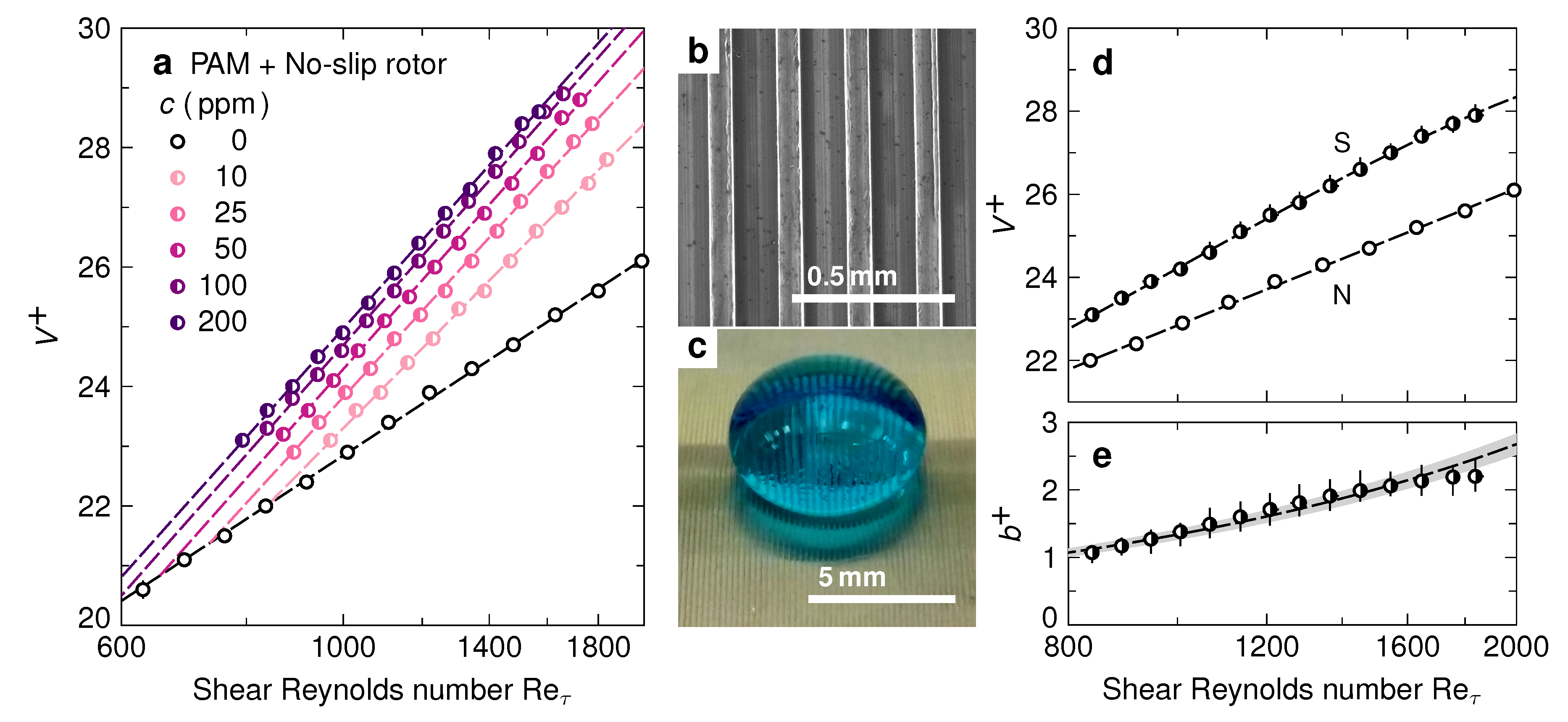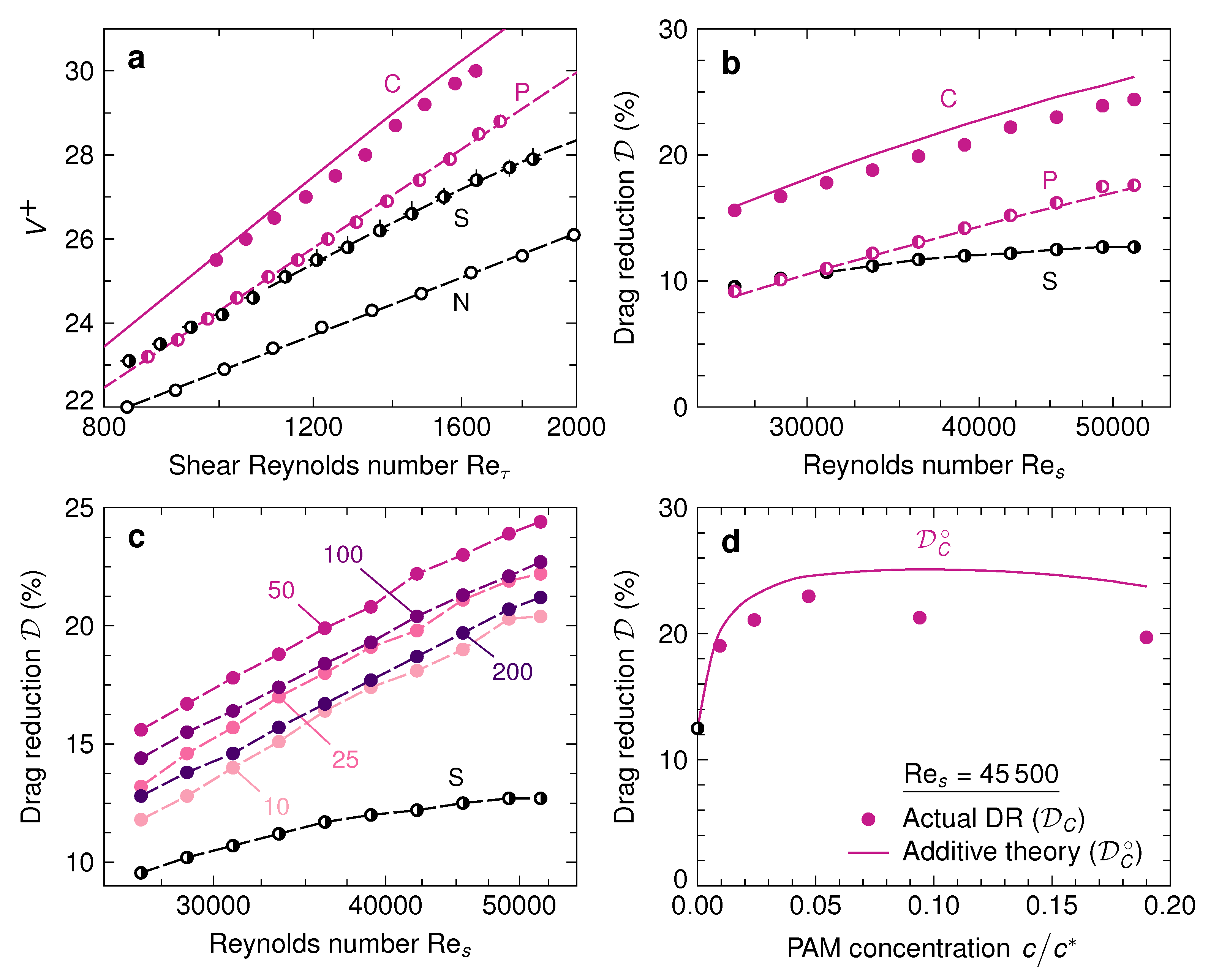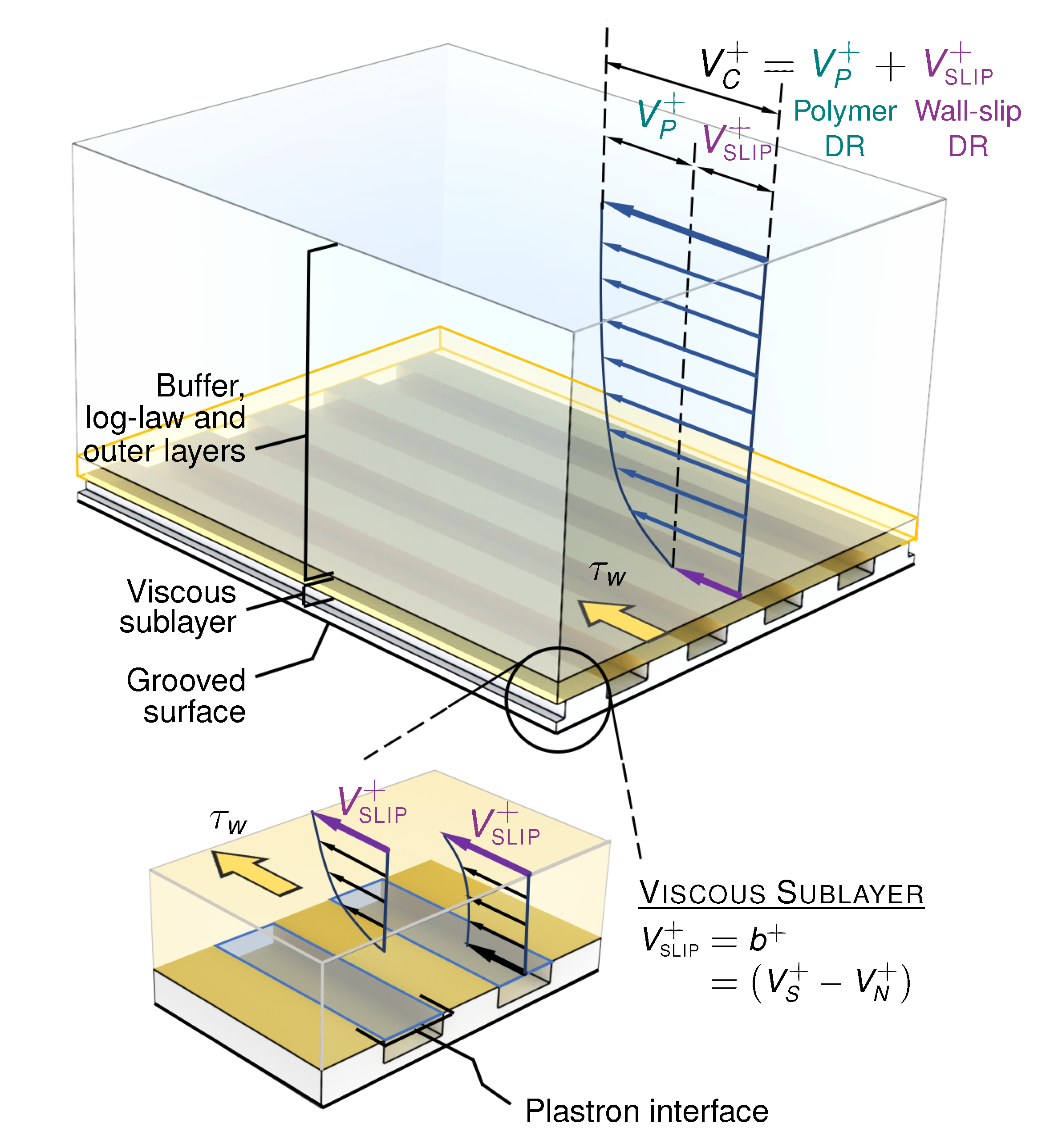Polymers and Plastrons in Parallel Yield Enhanced Turbulent Drag Reduction
Abstract
1. Introduction
2. Materials and Methods
2.1. Experimental Skin Friction Measurements
2.2. Fabrication of the Superhydrophobic Grooved Surface
2.3. Preparation of Polyacrylamide Solutions
3. Results
3.1. Water + No-Slip Rotor
3.2. Polymer Solution + No-Slip Rotor
3.3. Water + Superhydrophobic Rotor
3.4. Polymer + Superhydrophobic Rotor
4. Discussion
Supplementary Materials
Author Contributions
Funding
Acknowledgments
Conflicts of Interest
References
- Tennekes, H.; Lumley, J.L. A First Course in Turbulence; The MIT Press: Cambridge, MA, USA, 1972. [Google Scholar]
- Pope, S.B. Turbulent Flows; Cambridge University Press: Cambridge, UK, 2000. [Google Scholar]
- Stone, P.A.; Waleffe, F.; Graham, M.D. Toward a structural understanding of turbulent drag reduction: Nonlinear coherent states in viscoelastic shear flows. Phys. Rev. Lett. 2002, 89, 208301. [Google Scholar] [CrossRef] [PubMed]
- Roy, A.; Morozov, A.; van Saarloos, W.; Larson, R.G. Mechanism of polymer drag reduction using a low-dimensional model. Phys. Rev. Lett. 2006, 97, 234501. [Google Scholar] [CrossRef] [PubMed]
- Kim, K.; Adrian, R.J.; Balachandar, S.; Sureshkumar, R. Dynamics of hairpin vortices and polymer-induced turbulent drag reduction. Phys. Rev. Lett. 2008, 100, 134504. [Google Scholar] [CrossRef] [PubMed]
- Xi, L.; Graham, M.D. Active and hibernating turbulence in minimal channel flow of Newtonian and polymeric fluids. Phys. Rev. Lett. 2010, 104, 218301. [Google Scholar] [CrossRef] [PubMed]
- Xi, L.; Graham, M.D. Dynamics on the laminar-turbulent boundary and the origin of the maximum drag reduction asymptote. Phys. Rev. Lett. 2012, 108, 028301. [Google Scholar] [CrossRef]
- Martell, M.B.; Rothstein, J.P.; Perot, J.B. An analysis of superhydrophobic turbulent drag reduction mechanisms using direct numerical simulation. Phys. Fluids 2010, 22, 065102. [Google Scholar] [CrossRef]
- Park, H.; Park, H.; Kim, J. A numerical study of the effects of superhydrophobic surface on skin-friction drag in turbulent channel flow. Phys. Fluids 2013, 25, 110815. [Google Scholar] [CrossRef]
- Rastegari, A.; Akhavan, R. On the mechanism of turbulent drag reduction with super-hydrophobic surfaces. J. Fluid Mech. 2015, 773, R4. [Google Scholar] [CrossRef]
- Perlin, M.; Dowling, D.R.; Ceccio, S.L. Freeman scholar review: Passive and active skin-friction drag reduction in turbulent boundary layers. J. Fluids Eng. 2016, 138, 091104. [Google Scholar] [CrossRef]
- Graham, M.D. Drag reduction and the dynamics of turbulence in simple and complex fluids. Phys. Fluids 2014, 26, 101301. [Google Scholar] [CrossRef]
- Xi, L. Turbulent drag reduction by polymer additives: Fundamentals and recent advances. Phys. Fluids 2019, 31, 121302. [Google Scholar]
- Hoyt, J.W. The effect of additives on fluid friction. J. Basic Eng. 1972, 94, 258–285. [Google Scholar] [CrossRef]
- Virk, P.S. Drag reduction fundamentals. AIChE J. 1975, 21, 625–656. [Google Scholar] [CrossRef]
- White, C.M.; Mungal, M.G. Mechanics and prediction of turbulent drag reduction with polymer additives. Annu. Rev. Fluid Mech. 2008, 40, 235–256. [Google Scholar] [CrossRef]
- Han, W.J.; Choi, H.J. Role of bio-based polymers on improving turbulent flow characteristics: Materials and applications. Polymers 2017, 9, 209. [Google Scholar] [CrossRef] [PubMed]
- Han, W.J.; Dong, Y.Z.; Choi, H.J. Applications of water-soluble polymers in turbulent drag reduction. Processes 2017, 5, 24. [Google Scholar] [CrossRef]
- McHale, G.; Newton, M.I.; Shirtcliffe, N.J. Immersed superhydrophobic surfaces: Gas exchange, slip and drag reduction properties. Soft Matter 2010, 6, 714–719. [Google Scholar] [CrossRef]
- Rothstein, J.P. Slip on superhydrophobic surfaces. Annu. Rev. Fluid Mech. 2010, 42, 89–109. [Google Scholar] [CrossRef]
- Bhushan, B.; Jung, Y.C. Natural and biomimetic artificial surfaces for superhydrophobicity, self-cleaning, low adhesion, and drag reduction. Prog. Mater. Sci. 2011, 56, 1–108. [Google Scholar] [CrossRef]
- Golovin, K.B.; Gose, J.W.; Perlin, M.; Ceccio, S.L.; Tuteja, A. Bioinspired surfaces for turbulent drag reduction. Phil. Trans. R. Soc. A 2016, 374, 20160189. [Google Scholar] [CrossRef]
- Watanabe, K.; Udagawa, H. Drag reduction of Non-Newtonian fluids in a circular pipe with a highly water-repellent wall. AIChE J. 2001, 47, 256–262. [Google Scholar] [CrossRef]
- Seo, J.; García-Mayoral, R.; Mani, A. Pressure fluctuations and interfacial robustness in turbulent flows over superhydrophobic surfaces. J. Fluid Mech. 2015, 783, 448–473. [Google Scholar] [CrossRef]
- Park, H.; Sun, G.; Kim, C.J. Superhydrophobic turbulent drag reduction as a function of surface grating parameters. J. Fluid Mech. 2014, 747, 722–734. [Google Scholar] [CrossRef]
- Rajappan, A.; Golovin, K.; Tobelmann, B.; Pillutla, V.; Abhijeet; Choi, W.; Tuteja, A.; McKinley, G.H. Influence of textural statistics on drag reduction by scalable, randomly rough superhydrophobic surfaces in turbulent flow. Phys. Fluids 2019, 31, 042107. [Google Scholar] [CrossRef]
- Davis, E.A.; Park, J.S. Turbulence dynamics of dilute polymer solutions: Apparent slip and the effect of slip-inducing surfaces. In Proceedings of the 91st Annual Meeting of the Society of Rheology, Raleigh, NC, USA, 20–24 October 2019. [Google Scholar]
- Srinivasan, S.; Kleingartner, J.A.; Gilbert, J.B.; Cohen, R.E.; Milne, A.J.B.; McKinley, G.H. Sustainable drag reduction in turbulent Taylor-Couette flows by depositing scalable superhydrophobic surfaces. Phys. Rev. Lett. 2015, 114, 014501. [Google Scholar] [CrossRef]
- Rajappan, A.; McKinley, G.H. Epidermal biopolysaccharides from plant seeds enable biodegradable turbulent drag reduction. Sci. Rep. 2019, 9, 18263. [Google Scholar] [CrossRef]
- Panton, R.L. Scaling laws for the angular momentum of a completely turbulent Couette flow. C. R. Acad. Sci. Paris Ser. II 1992, 315, 1467–1473. [Google Scholar]
- Lathrop, D.P.; Fineberg, J.; Swinney, H.L. Transition to shear-driven turbulence in Couette-Taylor flow. Phys. Rev. A 1992, 46, 6390–6405. [Google Scholar] [CrossRef]
- Lewis, G.S.; Swinney, H.L. Velocity structure functions, scaling and transitions in high Reynolds number Couette-Taylor flow. Phys. Rev. E 1999, 59, 5457–5467. [Google Scholar] [CrossRef]
- McCarthy, K.J.; Burkhardt, C.W.; Parazak, D.P. Mark-Houwink-Sakurada constants and dilute solution behavior of heterodisperse poly(acrylamide-co-sodium acrylate) in 0.5 M and 1 M NaCl. J. Appl. Polym. Sci. 1987, 33, 1699–1714. [Google Scholar] [CrossRef]
- Rubinstein, M.; Colby, R.H. Polymer Physics; Oxford University Press: Oxford, UK, 2003. [Google Scholar]
- Buren, T.V.; Smits, A.J. Substantial drag reduction in turbulent flow using liquid-infused surfaces. J. Fluid Mech. 2017, 827, 448–456. [Google Scholar] [CrossRef]
- Philip, J.R. Flows satisfying mixed no-slip and no-shear conditions. Z. Angew. Math. Phys. 1972, 23, 353–372. [Google Scholar] [CrossRef]
- Min, T.; Kim, J. Effects of hydrophobic surface on skin-friction drag. Phys. Fluids 2004, 16, L55. [Google Scholar] [CrossRef]
- Fairhall, C.T.; García-Mayoral, R. Spectral analysis of the slip-length model for turbulence over textured superhydrophobic surfaces. Flow Turbul. Combust. 2018, 100, 961–978. [Google Scholar] [CrossRef]
- Sbragaglia, M.; Prosperetti, A. A note on the effective slip properties for microchannel flows with ultrahydrophobic surfaces. Phys. Fluids 2007, 19, 043603. [Google Scholar] [CrossRef]
- Steinberger, A.; Cottin-Bizonne, C.; Kleimann, P.; Charlaix, E. High friction on a bubble mattress. Nat. Mater. 2007, 6, 665–668. [Google Scholar] [CrossRef] [PubMed]
- Kim, M.W.; Cao, B.H. Additional reduction of surface tension of aqueous polyethylene oxide (PEO) solution at high polymer concentration. Europhys. Lett. 1993, 24, 229–234. [Google Scholar] [CrossRef]
- Peaudecerf, F.J.; Landel, J.R.; Goldstein, R.E.; Luzzatto-Fegiz, P. Traces of surfactants can severely limit the drag reduction of superhydrophobic surfaces. Proc. Natl. Acad. Sci. USA 2017, 114, 7254–7259. [Google Scholar] [CrossRef]
- Hu, R.Y.Z.; Wang, A.T.A.; Hartnett, J.P. Surface tension measurement of aqueous polymer solutions. Exp. Therm. Fluid Sci. 1991, 4, 723–729. [Google Scholar] [CrossRef]



Publisher’s Note: MDPI stays neutral with regard to jurisdictional claims in published maps and institutional affiliations. |
© 2020 by the authors. Licensee MDPI, Basel, Switzerland. This article is an open access article distributed under the terms and conditions of the Creative Commons Attribution (CC BY) license (http://creativecommons.org/licenses/by/4.0/).
Share and Cite
Rajappan, A.; McKinley, G.H. Polymers and Plastrons in Parallel Yield Enhanced Turbulent Drag Reduction. Fluids 2020, 5, 197. https://doi.org/10.3390/fluids5040197
Rajappan A, McKinley GH. Polymers and Plastrons in Parallel Yield Enhanced Turbulent Drag Reduction. Fluids. 2020; 5(4):197. https://doi.org/10.3390/fluids5040197
Chicago/Turabian StyleRajappan, Anoop, and Gareth H. McKinley. 2020. "Polymers and Plastrons in Parallel Yield Enhanced Turbulent Drag Reduction" Fluids 5, no. 4: 197. https://doi.org/10.3390/fluids5040197
APA StyleRajappan, A., & McKinley, G. H. (2020). Polymers and Plastrons in Parallel Yield Enhanced Turbulent Drag Reduction. Fluids, 5(4), 197. https://doi.org/10.3390/fluids5040197




